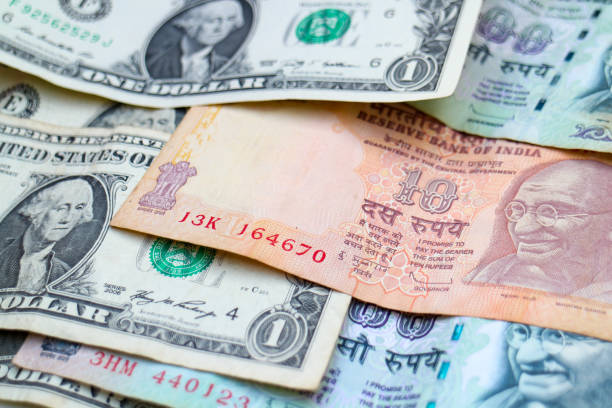
The Indian Rupee attracts some sellers in Monday’s Asian session.
An intensifying trade war triggered by Trump’s tariff policy weighs on the INR.
Investors brace for the RBI interest rate decision on Wednesday, which is anticipated to cut rates by 25 bps.
The Indian Rupee (INR) trades in negative territory on Monday. The local currency remains under pressure after US President Donald Trump unveiled a bigger-than-expected wall of tariffs around the world's largest economy, upending trade and supply chains. On the other hand, a fall in crude oil prices might help limit the INR’s losses. It’s worth noting that India is the world's third-largest oil consumer, and lower crude oil prices tend to have a positive impact on the Indian currency value.
Investors will monitor how trade tariffs affect foreign exchange markets. The Reserve Bank of India (RBI) will announce its policy decision on Wednesday and is widely expected to cut rates by 25 basis points (bps) amid expectations that monetary policy may turn more supportive as tariffs threaten to hurt economies globally.
Indian Rupee loses traction as Trump tariffs shock continues
The HSBC final India Services Purchasing Managers' Index (PMI), compiled by S&P Global, improved to 58.5 in March from a preliminary estimate of 57.5. The HSBC Indian Composite PMI rose to 59.5 in March, compared to a preliminary reading of 58.6.
Trump said last week that he would impose a 26% tariff on imports from India effective from April 9, a component of his comprehensive plan to place duties on all US imports.
US Nonfarm Payrolls (NFP) rose by 228,000 in March from the revised 117,000 in February, according to the Labor Department on Friday. This figure came in stronger than the 135,000 expected.
The US Unemployment Rate ticked up to 4.2% in March versus 4.1% prior, higher than the 4.1% forecast. Average Hourly Earnings increased 0.3% MoM in March, in line with the market consensus, while the annual rate of Average Hourly Earnings rose 3.8%, the lowest level since July 2024.
Federal Reserve (Fed) Chair Jerome Powell said on Friday that inflation is likely to pick up because of Trump’s sweeping tariffs and could remain elevated.
USD/INR’s outlook remains bearish under the 100-day EMA
The Indian Rupee weakens on the day. However, in the longer term, the bearish outlook of the USD/INR pair remains in place as the price is below the key 100-day Exponential Moving Average (EMA) on the daily timeframe. The downward momentum is reinforced by the 14-day Relative Strength Index (RSI), which stands below the midline near 38.90, suggesting that the path of least resistance is to the downside.
The initial support level for USD/INR is located at 85.20, the low of April 3. Extended losses could see a drop to the 85.00 psychological level. The additional downside filter to watch is 84.84, the low of December 19.
On the upside, the 100-day EMA at 85.87 acts as an immediate resistance level for the pair. Any follow-through buying above this level could pave the way to 86.48, the low of February 21, en route to 87.00, the round mark.
Indian Rupee FAQs
The Indian Rupee (INR) is one of the most sensitive currencies to external factors. The price of Crude Oil (the country is highly dependent on imported Oil), the value of the US Dollar – most trade is conducted in USD – and the level of foreign investment, are all influential. Direct intervention by the Reserve Bank of India (RBI) in FX markets to keep the exchange rate stable, as well as the level of interest rates set by the RBI, are further major influencing factors on the Rupee.
The Reserve Bank of India (RBI) actively intervenes in forex markets to maintain a stable exchange rate, to help facilitate trade. In addition, the RBI tries to maintain the inflation rate at its 4% target by adjusting interest rates. Higher interest rates usually strengthen the Rupee. This is due to the role of the ‘carry trade’ in which investors borrow in countries with lower interest rates so as to place their money in countries’ offering relatively higher interest rates and profit from the difference.
Macroeconomic factors that influence the value of the Rupee include inflation, interest rates, the economic growth rate (GDP), the balance of trade, and inflows from foreign investment. A higher growth rate can lead to more overseas investment, pushing up demand for the Rupee. A less negative balance of trade will eventually lead to a stronger Rupee. Higher interest rates, especially real rates (interest rates less inflation) are also positive for the Rupee. A risk-on environment can lead to greater inflows of Foreign Direct and Indirect Investment (FDI and FII), which also benefit the Rupee.
Higher inflation, particularly, if it is comparatively higher than India’s peers, is generally negative for the currency as it reflects devaluation through oversupply. Inflation also increases the cost of exports, leading to more Rupees being sold to purchase foreign imports, which is Rupee-negative. At the same time, higher inflation usually leads to the Reserve Bank of India (RBI) raising interest rates and this can be positive for the Rupee, due to increased demand from international investors. The opposite effect is true of lower inflation.
* The content presented above, whether from a third party or not, is considered as general advice only. This article should not be construed as containing investment advice, investment recommendations, an offer of or solicitation for any transactions in financial instruments.

